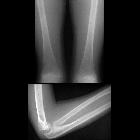thyreoidale Akropachie

Graves’
disease thyroid dermopathy: a case report. Standard ultrasound scan of the feet showed bilateral multiple fairly well-defined heterogeneously hypoechoic cutaneous/subcutaneous nodules. The largest nodule is seen around the left ankle joint, which measures 3.33 × 0.72 cm (a). The similar smaller lesion seen in the dorsum of the left measures 2.20 × 0.79 cm, with no evidence of extension to deep structures and no internal vascularity or calcifications (b). These nodules are of non-specific sonographic appearance

Thyroid
acropachy • Thyroid acropachy - Ganzer Fall bei Radiopaedia

Graves’
disease thyroid dermopathy: a case report. Pelvis magnetic resonance imaging showed non-specific subcutaneous soft tissue thickening surrounding the penis (see the red arrows). No evidence of collections/lymphatic malformation within the pelvic region

Graves’
disease thyroid dermopathy: a case report. Multiple nodules on sites of cautery
Thyroid acropachy is an unusual presentation of autoimmune thyroid disease, (~1% of patients with Graves disease). It can occur in hyperthyroid, euthyroid, hypothyroid, or even post-treatment patients. It is almost always associated with thyroid ophthalmopathy.
Epidemiology
The majority of patients are smokers.
Clinical presentation
Clinically, it presents with soft tissue swelling, finger clubbing, and periosteal reaction of the extremities.
Radiographic features
Plain radiograph
- hands and feet involvement
- tubular bones
- usually bilateral and symmetrical
- prominent smooth flowing periosteal reaction with new bone formation at the metacarpals and phalanges
- soft tissue swelling (especially lower limbs) may be present
Differential diagnosis
- hypertrophic pulmonary osteoarthropathy
- pachydermoperiostosis
- hypervitaminosis A
- chronic vascular insufficiency
- voriconazole induced periostitis
Siehe auch:
- Morbus Basedow
- hypertrophe Osteoarthropathie
- vitamin A intoxication
- hypertrophic pulmonary osteoathropathy
und weiter:

 Assoziationen und Differentialdiagnosen zu thyreoidale Akropachie:
Assoziationen und Differentialdiagnosen zu thyreoidale Akropachie:


